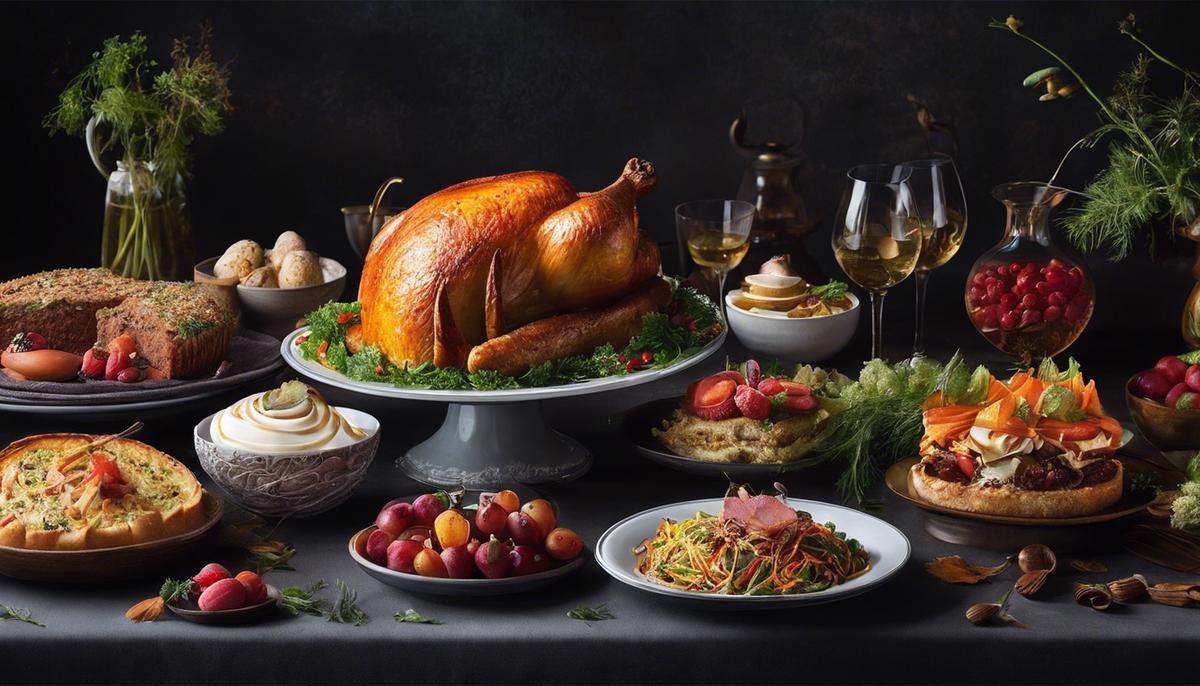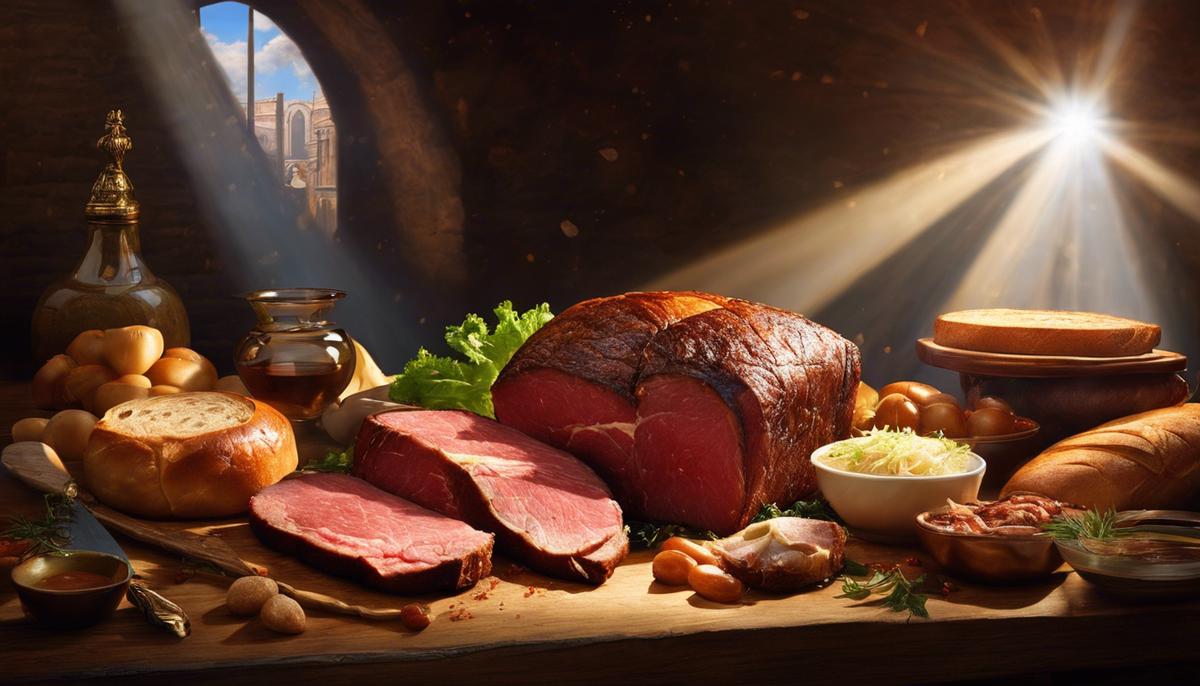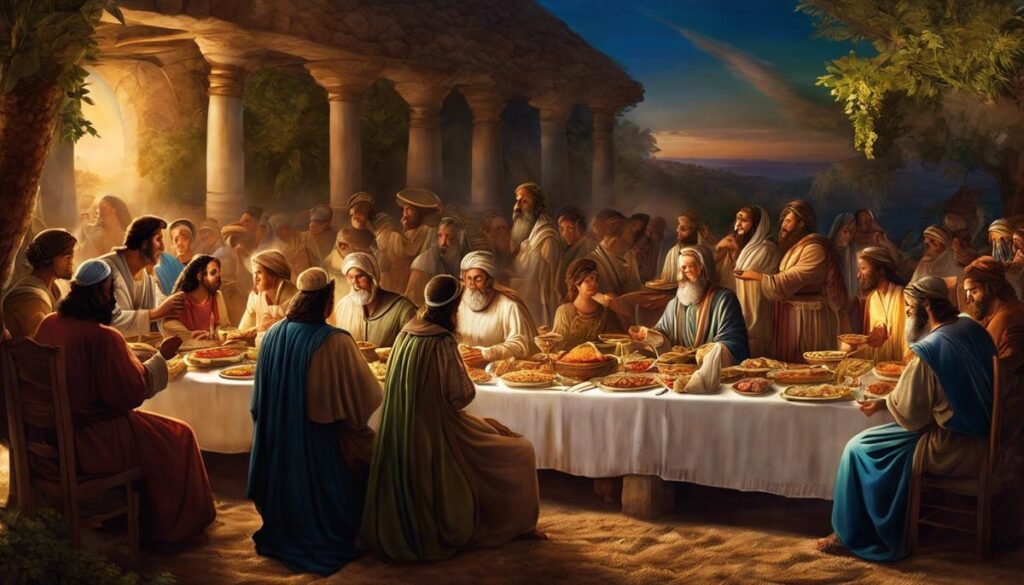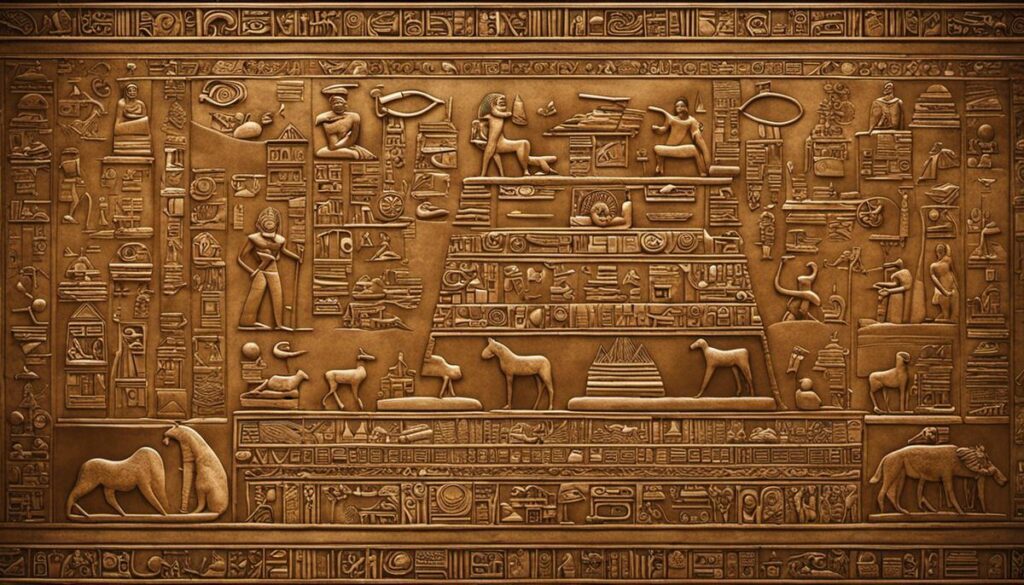The realm of dreams has long captivated the human imagination, serving as a bridge between the conscious and the subconscious, the material and the spiritual. Among these nocturnal visions, the act of eating holds considerable sway, woven deeply into the tapestry of biblical narratives and ancient traditions. In the scriptures, dreams transcend simple night-time reveries to become vessels of divine communication and reflection. By exploring the historical context of eating in biblical dreams, we gain insight into the foundations of scriptural interpretation and unlock the rich symbology that has influenced Judeo-Christian thought for millennia. From the feasting tables of Solomon to the visionary encounters of Daniel, this journey into the corporeal act of eating within the spectral world of dreams invites us to discover meanings that resonate with both our physical existence and our spiritual yearnings.
Historical Context of Eating in Biblical Dreams
The Feasting Dreams of Antiquity: Biblical Accounts Illuminated by Historical Context
In deciphering the profound narratives encoded within biblical text, particular attention must be directed toward the dreams that feature eating, a fundamental human activity laced with cultural and spiritual significance. The interpretation of eating within biblical dreams is not merely a trivial matter, but one that requires an elucidation grounded in an understanding of the historical context in which these texts were composed.
The Holy Scriptures are replete with instances of dreams acting as divine channels for communication, often weaving eating and feasting into their fabric to convey messages of considerable import. To unpack these messages, one must consider the societal, religious, and economic milieu of the ancient Near East—a milieu suffused with the symbolism of sustenance and famine.
For instance, the interpretation of eating in Pharaoh’s dream, as recounted in the book of Genesis, cannot be extricated from the agricultural calendar and the socio-economic reality of ancient Egypt. The dream’s representation of seven well-favoured kine being devoured by seven ill-favoured kine (Genesis 41:1-7), when understood against the backdrop of a society deeply reliant on the seasonal flooding of the Nile for agricultural fertility, is revealed as a harbinger of seven prosperous years followed by seven years of famine. This vision held profound implications both theologically, as a testament to divine foresight and providence, and politically, as it furnished Joseph with an opportunity to demonstrate his divinely-endowed wisdom, which ultimately led to his rise to prominence.
Moreover, dreams featuring eating can be interpreted through religio-culinary practices of the Israelites, highly governed by Mosaic dietary laws. Dreams concerning food, therefore, are not merely illustrations of physical hunger but carry a dense tapestry of meanings related to purity, communal identity, and covenant relationship with the divine. Such is witnessed in the book of Daniel, where Daniel’s refusal to defile himself with the royal food and wine (Daniel 1:8) not only reflects adherence to Levitical laws but also serves as a symbolic act of resistance against assimilation into the dominant Babylonian culture.
Additionally, in light of historical context, one must not overlook the role of feasts and banquets as manifestations of social dynamics and power relations in biblical times. Dreams portraying feasts frequently embody the themes of covenantal blessings, divine abundance, and the eschatological hope for restoration and redemption. The prophetic literature, with its eschatological visions of sumptuous banquets (Isaiah 25:6-8), crystalizes the expectations of an era when social disparity and food insecurity are to be vanquished by divine largesse.
In concluding, the elucidation of eating in biblical dreams demands an immersion into the historical context of these ancient societies. This approach enables one to glean deeper theological and existential insights from the sacred text. Dreams laden with culinary symbols extend beyond basic sustenance, touching upon the divine-human relationship, societal structures, and eschatological anticipations. The interpretation of these oneiric visions, through the prism of the historical context, enriches contemporary appreciation and comprehension of biblical wisdom and its enduring relevance.

Scriptural References to Eating in Dreams
In the pursuit of understanding scriptural references involving the act of dining within dreams, we must direct our attention to key passages that are imbued with considerable interpretative weight.
An elucidation of these references yields insights into the metaphysical frameworks and the moral architectures of the societies from which these texts emerged.
Notably, the Book of Daniel presents a critical exploration of eating in dreams. Daniel 1:8-16 recounts how Daniel and his companions choose not to defile themselves with the royal food and wine during their stay in Babylon. Instead of consuming the king’s offerings, they request permission to subsist on vegetables and water. The consequence of this subsistence is revealed through a divinely-granted vision, awarded to Daniel and his companions, portraying them with healthier countenances than those who partook in the royal feast. This passage serves as an allegory, emphasizing the gains of spiritual integrity over temporal indulgence. It subtly conveys the notion that faithfulness in adhering to divine laws—represented through dietary abstention—results in divine favor, even in oppressive circumstances.
The book of Proverbs also subtly references the concept of eating in dreams in the form of wisdom literature. Proverbs 19:24 illustrates the fate of a sluggard whose hand is buried in the dish, yet he is too lazy to bring it to his mouth. While not explicitly a dream, this metaphorical expression can be extrapolated to a dream-like state of inaction—where the acquisition of sustenance remains incomplete. Such a portrayal acts as an instructional paradigm, warning that spiritual and intellectual lethargy can lead to unfulfilled potential, much like the unsated hunger in a dream.
In extrapolating the meaning behind such scriptural occurrences, it is paramount to recognize that the act of eating in dreams is emblematic, projecting a spectrum spanning from divine favor to slothful indolence. These dream sequences serve as reflections of a societal ethos where sustenance and consumption were not merely acts of physical necessity but symbolized wider cosmic and moral orders. Biblical conveyances of dream feasting or abstaining are therefore not solely indicative of one’s physical state but suggest a more profound examination of one’s spiritual and ethical standing.
As scholars and enthusiasts of biblical exegesis and dream interpretation, an acknowledgment of the contextual nuance and the encoded significances hidden within these ancient texts positions us to appreciate the profound depth they offer. Whether seen as heavenly communication or as moral signifiers, the biblical episodes of epicurean experiences in dreams are a testament to the rich tapestry of human-divine interaction and the complex nexus of alimentary symbolism embedded within semitic scriptural heritage.

Symbolic Meanings of Food in Biblical Dreams
The Prophetic Visions of Meat and Bread: Nourishment as Eschatological Symbols
In the study of biblical dreams, where divine messaging often takes a central role, attention must be given to the specific elements within these visions, especially sustenance. Meat and bread, as encountered in the prophetic literature, carry with them deep symbolic meanings that transcend mere nutritional value, painting a broader picture of divine providence and human reliance on spiritual sustenance.
The portrayal of meat in a dream or vision, such as in the book of Ezekiel, typically signifies forthcoming judgment or abundance, dependent upon the context and narrative structure. For instance, the consumption of unclean meat could denote transgression and impending chastisement, referencing dietary laws and socio-religious boundary markers.
Conversely, bread, a staple foodstuff in the ancient Near Eastern diet, often symbolizes God’s steadfast provision for His people. For example, in the dream of the Midianite in the book of Judges, Gideon is emboldened by the vision of a loaf of barley bread that tumbles into the enemy camp—this symbolizing the power of Yahweh to utilize even the most seemingly insignificant means to bring about victory. The bread here is emblematic of nourishment that extends beyond physical sustenance and reflects the divine support present even in adversity.
The connotations of leavened versus unleavened bread further develop this theme. Within the Passover narrative, the elimination of leaven, a symbol of corruption and sin, and the consumption of unleavened bread during the Israelites’ hasty departure from Egypt underscores purity and obedience to divine commandments as they prepare for liberation and a new covenantal relationship with God.
Alongside the symbolism of meat and bread, fruit and wine in dreams often represent fertility, blessing, and joy, as well as judgment when presented in a withered or spoiled state. For instance, in the prophetic dreams of Joseph, grapes being pressed into Pharaoh’s cup signify regal restoration, yet similar imagery of a fruit-bearing vine or tree could just as easily signify national prosperity or an individual’s upright moral standing.
Biblical dream sequences involving food elements extend beyond mere storytelling. The dreamt consumption or presence of these foodstuffs conveys complex relational dynamics between deity and worshipper, community and outsider, bounty and famine—all of which resonate with the society’s recognition of divine sovereignty and moral alignment determined by adherence to God’s laws.
Furthermore, these eschatological symbols elucidate an intricate tapestry of cultural values and divine revelations, uniquely manifest in the dietary metaphors of ancient scriptural passages. The visions of sustenance within biblical dreams not only provide an exegetical lens into past religio-cultural truths but also speak volumes on the theologically rich narratives that guide modern understanding of the sacrosanct.
This exegesis on the symbolic meaning of various foods in biblical dreams permits a glimpse into the profound theological exploration where everyday elements such as meat and bread transcend their material existence to convey messages of spiritual import. Their representation in prophetic literature serves as a reminder of the omnipresent divine care and the continuity of theological inquiry through the symbols encoded in humanity’s earliest spiritual records.

Psychological and Theological Perspectives
The Delicate Weave of Nutrition and Divinity: Analyzing the Symbolic Essence of Foodstuffs in Biblical Oneirology
An examination of the psychological and theological perspectives within the Biblical canon synthesizes a profound understanding of the nutrition-divinity nexus. The corpus of scriptural narratives frequently utilizes the act of eating, as well as specific food items, to convey messages of a deeply spiritual and psychological nature, transcending the mere act of physical sustenance.
Within the anatomy of biblical dreams, distinct food substances carry unique symbolic significance. The symbolic meanings of meat, for instance, are multifaceted; at times, it represents abundance and providential care, whereas, in other contexts, it may denote sacrificial elements or the gravity of sin. Nuances within the portrayal of meat mirror the relationship between humanity and the divine, often reflecting stages of obedience, purity, and sanctification.
Bread, a staple of the ancient Near Eastern diet, also plays a pivotal role in oneiric symbols. In biblical dreams, the distinction between leavened and unleavened bread is especially illustrative. Leavened bread, often associated with daily life and commonality, contrasts sharply with unleavened bread, a symbol of purification and haste during sacred observances. These allusions underscore the deeply ingrained ritualistic meanings attached to bread and its integral part in fostering communal and divine fellowship.
Fruit and wine, each with their own set of symbolic associations, further enhance the textual and dream tapestry. Wine may signify joy and celebration or act as an omen of wrath and judgment, depending on its contextual usage in the dreamscape. Fruit, similarly, brings forth ideas of divine provision, temptation, or even eschatological promises of renewal. Such elements of the diet provide an accessible allegory through which theological principles are demonstrated, often carrying within them the seeds of morality and the potential for spiritual enlightenment or downfall.
The consumption or mere presence of food in biblical dreams frequently illuminates complex relational dynamics, whether between individuals, social entities, or the human and the divine. These interactions possess not simply transactional value but are laden with signifiers of covenant, reconciliation, and providential watchcare.
Through the medium of dietary metaphors, the ancient scripture, rich in cultural values and divine revelations, elegantly bridges the temporal with the eternal. The narratives serve not merely to elucidate societal norms but herald a deeper resonance that vibrates within the surrounding divine framework.
In the theological exploration and spiritual import found in biblical dreams, everyday elements reveal a panorama of spiritual truth, manifesting the omnipresence of divine care. Such elements draw attention to the divine relevance intrinsic to the mundane features of our existence and underscore the continuity and development of theological inquiry throughout history.
Succinctly, the alimentary symbolism found in humanity’s earliest spiritual records, particularly within the context of oneiric revelations, affords an enduring tapestry of understanding. Nourishment in dreams speaks to themes far beyond the viscerally physical, acting as vessels for divine communication that hold within them the potential to shape human behavior, dictate societal norms, and impart sacred wisdom. These motifs continue to offer invaluable insight, shaping both contemporary theological discourse and modern psychological analyses of scriptural narratives. Through this continuing exploration, the depth of psychological and theological reflections on eating in biblical dreams ensures that their significance remains as nourishing to the intellect as it is to the soul.

Contemporary Applications and Dream Analysis
Contemporary Interpretations of Dietary Aspects in Biblical Dream Analysis
In the field of contemporary dream analysis, relying on knowledge from ancient texts can provide crucial insights. Given the extensive enumeration of the dietary elements present in the aforementioned biblical dream narratives and their multilayered interpretations, it is incumbent upon researchers today to examine how these elements are contextualized within modern dream exegesis. The interpretation of eating in dreams, a robust motif in ancient scripture, demands a thoughtful approach that blends psychological perspectives with theological reflections.
Carl Gustav Jung, a prominent figure in dream analysis, introduces the concept of archetypes—innate, universal symbols that manifest in individual psyches and cultural motifs. According to Jungian thought, eating symbolizes assimilation, not only of physical sustenance but also of psychological and spiritual nourishment. Thus the action of eating in dreams may represent the absorption of new information or experiences into the psyche.
Today’s analysis often extends beyond the material act depicted in the dream, probing into the symbolic sustenance that food represents. As such, the act of ingesting (or refraining from ingesting) certain foods in dreams can symbolize personal growth, acceptance of cultural values, or the internalization of divine will. These layers are particularly resonant when we consider the abstinence of Daniel and his companions, a narrative which addresses the spiritual fortitude required to adhere to one’s own principles.
Moreover, the very nature of the food depicted in a dream holds significance. For example, meat, often seen as a symbol of prosperity and sacrifice in the biblical context, may carry overtones of power or spiritual nourishment in contemporary analysis. Conversely, dreams involving scarce or spoiled food can evoke themes of spiritual starvation or ethical compromise.
The representation of bread, particularly its leavened or unleavened state, can draw from its scriptural basis to signify purity, simplicity, or a return to basics in modern interpretation. In a world increasingly defined by complexity, such symbolic longing for simplicity can resonate deeply with contemporary dreamers.
Fruits and wines, symbols of abundance and joy in the biblical tradition, can emerge in dreams as emblems of personal reward or spiritual fulfillment in the modern context. These elements can indicate a season of personal growth or reflect a psychospiritual state of thanksgiving and celebration.
In concert, the inclusion of these alimentary elements in dream analysis requires an understanding of the individual’s contemporary environment meshed with an appreciation for their rich cultural and religious heritage. Analysts and researchers must navigate the delicate balance between time-honored symbolism and current psychological theories to decode the messages conveyed through food in dreams.
The practice of interpreting dreams is enhanced by the acknowledgment of ancient traditions, offering valuable insights into the realms of the subconscious. It highlights unconscious drives intertwined with historical and spiritual legacies, revealing a spectrum of human experience that extends across millennia.
In summary, the integration of alimentary symbolism in dream analysis remains indispensable, providing a bridge that connects the spiritual wisdom of the past with the psychological understanding of the present. As we continue to unify the constructs of ancient narratives with contemporary dream analysis, the resonance of dietary symbols perpetuates a timeless dialogue between humanity and the divine, offering ever-expansive vistas in the pursuit of understanding the human condition.

Embarking on this exploration of eating in biblical dreams has allowed us to partake in a feast of knowledge, blending ancient wisdom with modern understanding. The interplay between historical, scriptural, symbolic, psychological, and theological dimensions provides a comprehensive palate from which to taste the complexities of dream interpretation. As we digest the multitude of interpretations and applications unearthed through this inquiry, we are reminded of the potent influence that our spiritual beliefs and cultural backgrounds exert on the dreamscape. Let us carry forward the nuanced flavors of this exploration, savoring the profound connections and individual revelations that dream analysis can reveal, as we continue to seek nourishment for both the mind and the soul in our quest for meaning.








